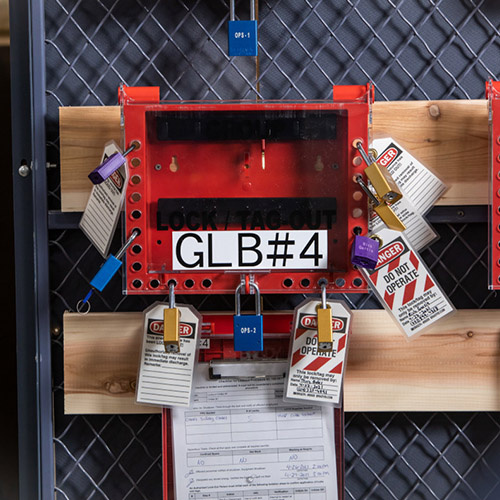Discover the advantages of working with a lockbox!
- Posted on
- Posted in group lockbox, lockbox, LOTO
- 0

In this article, we discuss the benefits of lockboxes, also known as group locks. We start with an overview of the different types of LOTO procedures and clarify in which procedures lockboxes are used. We then provide a detailed roadmap explaining how lockboxes can be used effectively to ensure the safety of multiple workers. Next, we discuss the different types of lockout lockboxes available through lockout-tagout-shop.com. Finally, we inform you where these products can be found in our webshop and how to contact us for free personal advice.
The different types of Lockout-Tagout (LOTO) security procedures
There are different forms of Lockout-Tagout used to secure machines during maintenance:
Simple Lockout - This involves isolating and locking a single machine or power source by one employee.
Simple Delegated Lockout - One person is responsible for isolating the machine, but the task can be delegated to others.
Simple Lockout with Multiple Participants - Multiple workers isolate the same energy source and place their own lock on the lockout equipment to ensure that the machine cannot be switched back on until everyone has removed their lock.
Complex Lockout (Group Lockout) - In complex systems or large teams, the use of a group a lockbox, is very important as multiple workers are involved in the process and safety must be maintained at all times. A lockbox provides an effective solution for the end manager to keep track of which workers are performing work on the machines and which are not. In the next section, we will elaborate further on how a lockbox works and its proper use.
|
Roadmap for Group lockout boxes: 1. Locking the machine or process In lockout situations involving a large number of workers and equipment, the end manager locks the machine or process by securing the energy isolation points with safety padlock(s). 2. Placing keys in the Lockbox After the machine or process is locked, the supervisor places all keys of the security padlocks of the isolated energy points in the lockbox. 3. Attachment of personal Lock and/or tag Each LOTO employee attaches their personal lock and/or tag to the lockbox. This ensures that the lockbox cannot be opened while there are employees working on the installation. 4. Removal of personal lock and/or tag by employees When an employee finishes their work, they remove the personal lock and/or tag from the lockbox. 5. Unlocking the group lock/lockbox The system can only be unlocked after all employees have removed their personal lock and/or tag. The final manager checks that all locks and tags have been removed before removing the keys from the lockbox and unlocking the energy isolation points. 6. Restarting the Installation! After verifying that all workers are at a safe distance from the machine, the plant can be safely restarted.
This roadmap ensures that the plant or machine is not unlocked until all concerned LOTO employees have completed their tasks and removed their personal security. |
 |
The process of working with lockboxes broadly follows the same steps, regardless of the specific model used. Nevertheless, there are considerable variations between the different types of lockboxes we offer at lockout-tagout-shop.com, each with unique features that address specific needs and working conditions.
Number of padlocks - First of all, lockboxes vary in the maximum number of padlocks that can be stored in the box. This is an important consideration, especially in situations where multiple employees are involved in the lockout/tagout procedure. Some lockboxes are designed to store a small number of padlocks, ideal for smaller teams or less complex tasks. Other variants can hold dozens of padlocks, making them suitable for large-scale projects where a large number of employees are working on an installation at the same time.
Colour - In addition to storage capacity, a variety of colours are also available. This is not only an aesthetic choice, but also a practical one. For example, colours can be used to distinguish different departments, teams or types of equipment, simplifying the process of identification and organisation.
Brands - Furthermore, we offer a wide range of brands, including renowned names such as ABUS, Brady and Masterlock. Each of these brands is known for their quality and reliability, but they also offer unique features that may make one more suitable than another, depending on the specific requirements of the working environment.
Fastening method - Another distinguishing feature of lockboxes is their fastening method. For example, some models are designed for wall mounting, allowing them to be permanently installed in a strategic location within a workspace. This type is ideal for fixed workstations where it is important that the lockbox is always available in the same place. On the other hand, there are portable lockboxes that can be easily transported from one location to another. This flexibility is particularly valuable in dynamic work environments where work changes location frequently. There are also lockboxes that can be both wall-mounted and easily removed from the wall for relocation.
Material - Finally, the material from which the lockbox is made is an important consideration. We offer lockboxes made from different materials, such as sturdy metal for maximum durability and resistance to tough working conditions, and lighter, yet durable materials such as acrylic. Each material offers specific benefits to suit the needs of different working environments and applications.
All these variations ensure that with us, you can always find the lockbox that perfectly suits your specific lockout/tagout needs. Find the lockbox that suits your situation here!



















Comments
Be the first to comment...